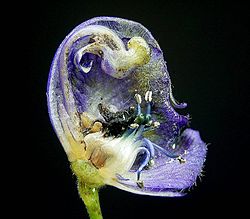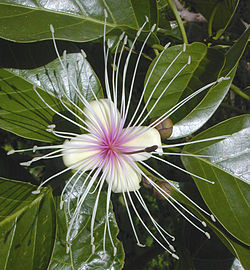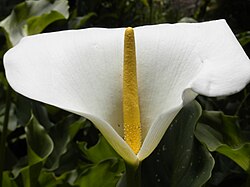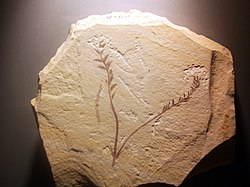Flower

A flower is the reproductive part of flowering plants. Flowers are also called the bloom or blossom of a plant. Flowers have petals. Inside the part of the flower that has petals are the parts which produce pollen and seeds.
In all plants, a flower is usually its most colourful part. We say the plant 'flowers', 'is flowering' or 'is in flower' when this colourful part begins to grow bigger and open out. There are many different kinds of flowers in different areas in the world. Even in the coldest places, for example the Arctic, flowers can grow during a few months.
Flowers may grow separately on the plant, or they may grow together in an inflorescence.[1]
Structure of flowers

To investigate the structure of a flower, it must be dissected, and its structure summarised by a floral diagram or a floral formula. Then its family can be identified with the aid of a flora, which is a book designed to help you identify plants.
Four basic parts
Flowers have four basic parts, from the outside in they are:
- The perianth, the vegetative parts
- The reproductive parts
Although this arrangement is typical, plant species show a wide variation in floral structure.[2] The modifications produced in the evolution of flowering plants are used by botanists to find relationships among plant species.
Flowers are an important evolutionary advance made by flowering plants. Some flowers are dependent upon the wind to move pollen between flowers of the same species. Their pollen grains are light-weight. Many others rely on insects or birds to move pollen. Their pollen grains are heavier. The role of flowers is to produce seeds. These are inside what botanists call the fruit. Fruits and seeds are a means of dispersal. Plants do not move, but wind, animals and birds spread the plants across the landscape.
Since the ovules are protected by carpels, it takes something special for fertilisation to happen. Angiosperms have pollen grains made of just three cells. One cell drills down through the integuments, to make a passage for the two sperm cells to flow down. The megagametophyte is a tiny haploid female plant which includes the egg. It has just seven cells. Of these, one is the egg cell; it fuses with a sperm cell, forming the zygote. Another cell joins with the other sperm, and forms a nutrient-rich endosperm. The other cells take auxiliary roles. This process of "double fertilisation" is unique, and is common to all angiosperms.
Evolution of flowers
Flowers are modified leaves. They are only present in flowering plants (angiosperms), which are relatively late to appear in the fossil record.
Early fossils of flowers and flowering plants are known from 130 million years ago, in the Lower Cretaceous.[3][4] However, flowers had a much longer history, the extent of which is not yet fully known.[5] There were flowers from the early Jurassic, 50 million years earlier than was previously thought.[6]
The flowering plants were thought to have evolved from within the gymnosperms. However, the known gymnosperms are a clade which is distinct from the angiosperms. Apparently, the two clades diverged (split) some 300 million years ago.[7] That is about the boundary of the Carboniferous period with the Permian period.
Uses of flowers
As decoration
Flowers have long been admired and used by humans. Most people think that flowers are beautiful. Many people also love flowers for their fragrances (scents). People enjoy seeing flowers growing in gardens. People also enjoy growing flowers in their backyards, outside their homes. People often wear flowers on their clothes or give flowers as a gift during special occasions, holidays, or rituals, such as the birth of a new baby (or a Christening), at weddings (marriages), at funerals (when a person dies). People often buy flowers from businesses called florists.
As a name
Some parents name their children, most often girls, after a flower. Some common flower names are: Rose, Lily, Daisy, Holly, Hyacinth, Jasmine, Blossom.[8]
As food
People eat some types of flowers. Flower vegetables include broccoli, cauliflower and artichoke. The most expensive spice, saffron, comes from the crocus flower. Other flower spices are cloves and capers. Hops flowers are used to flavor beer. Dandelion can be made into wine.
Honey is flower nectar that has been collected and processed by bees. Honey is often named by the type of flower that the bees are using (for example, clover honey). Some people put flowers from nasturtiums, chrysanthemums, or carnations in their food. Flowers can also be made into tea. Dried flowers, such as chrysanthemum, rose, and jasmine, can be used to make tea.
Special meanings
Flowers were used to signal meanings in the time when social meetings between men and women was difficult. Lilies made people think of life. Red roses made people think of love, beauty, and passion. In Britain, Australia and Canada, poppies are worn on special holidays as a mark of respect for those who served and died in wars. Daisies make people think of children and innocence.
Common flowers
| Wikimedia Commons has media related to Lua error in Module:Commons_link at line 62: attempt to index field 'wikibase' (a nil value).. |
FlowerStructure Of Flowers Media
Reproductive parts of easter lily (Lilium longiflorum). 1. Stigma, 2. Style, 3. Stamens, 4. Filament, 5. Petal
The calla lily is not a single flower. It is an inflorescence of tiny flowers pressed together on a central stalk that is surrounded by a large petal-like bract.
Archaefructus liaoningensis, one of the earliest known flowering plants
Related pages
References
- ↑ Beentje H. & Williamson J. 2010. The Kew Plant Glossary: an illustrated dictionary of plant terms. Royal Botanic Gardens, Kew: Kew Publishing.
- ↑ Sattler R. 1973. Organogenesis of flowers: a photographic text-atlas. University of Toronto Press. ISBN 0-8020-1864-5
- ↑ Crepet W.L. (2000). "Progress in understanding angiosperm history, success, and relationships: Darwin's abominably "perplexing phenomenon"". Proceedings of the National Academy of Sciences. 97 (24): 12939–41. Bibcode:2000PNAS...9712939C. doi:10.1073/pnas.97.24.12939. ISSN 0027-8424. PMC 34068. PMID 11087846.
- ↑ Wilson Nichols Stewart & Gar W. Rothwell 1993. Paleobotany and the evolution of plants. 2nd ed, Cambridge Univ. Press. ISBN 978-0-521-38294-6
- ↑ Cronquist A. 1981. The evolution and classification of flowering plants. Columbia Univ. Press, New York.
- ↑ Chinese Academy of Sciences Headquarters: [1]
- ↑ Nam, J.; Depamphilis, CW; Ma, H; Nei, M (2003). "Antiquity and evolution of the MADS-Box gene family controlling flower development in plants". Mol. Biol. Evol. 20 (9): 1435–1447. doi:10.1093/molbev/msg152. PMID 12777513.
- ↑ Pamela Redmond (15 October 2022). "Flower Names for Girls (and Boys)". Retrieved 19 October 2022.
Other websites
- Flower Citizendium












